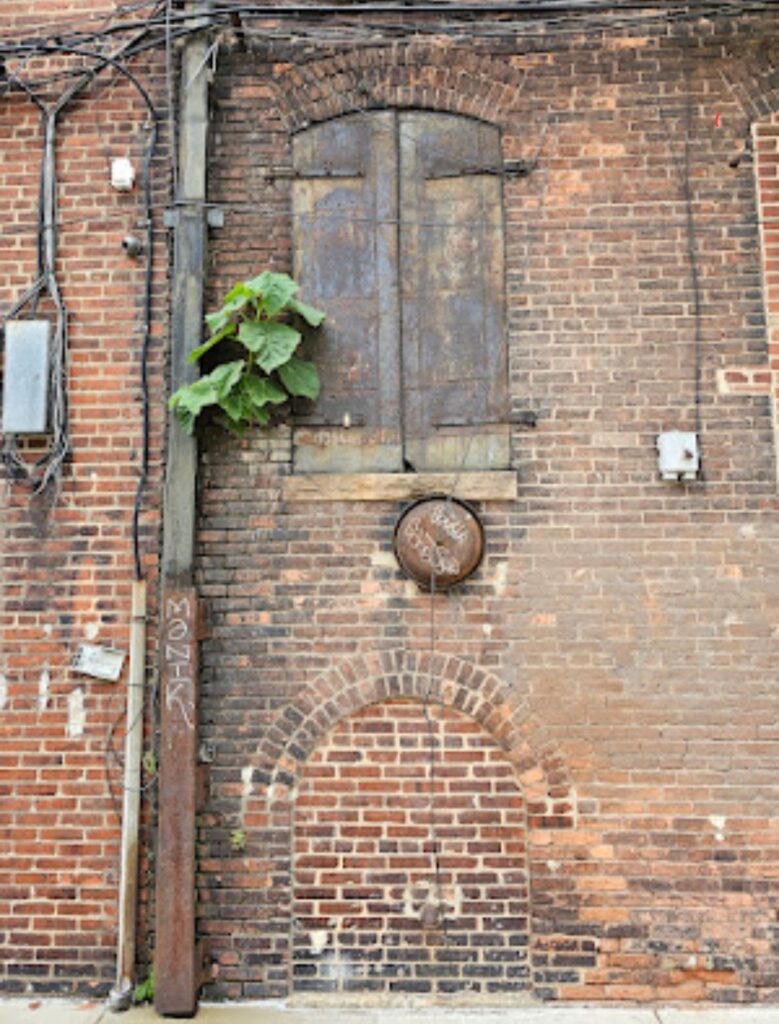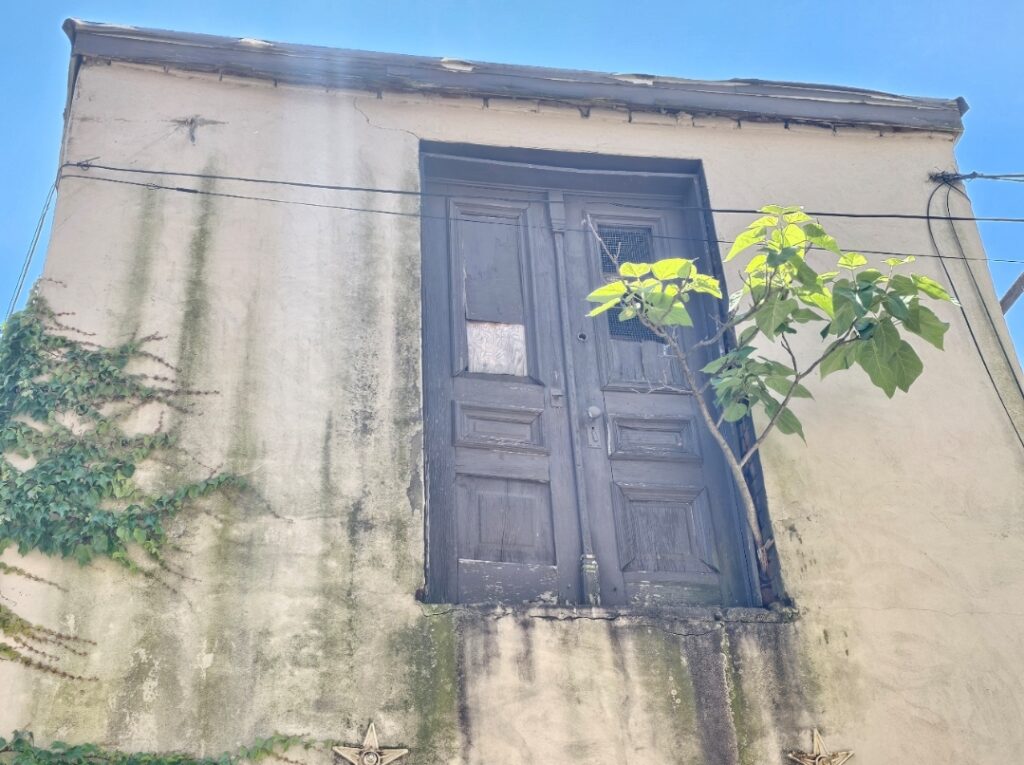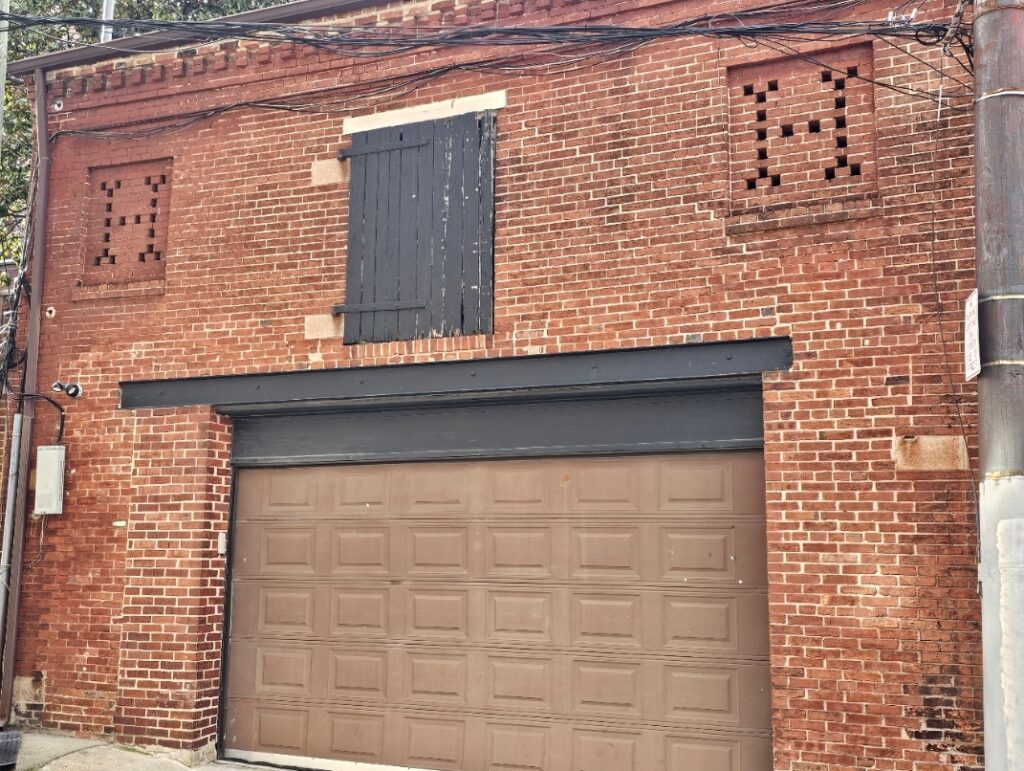Last week, we looked at part one of the same series on hay doors at some of the elevated levels of historic brick buildings here in Washington DC, often found behind residential row homes and or older industrial buildings. Today, we continue with the same topic looking at more of the photographs of the historic architectural and functional brickwork of these buildings and the hay doors. In some cases, these doors will be referred to as Lucarne doors.
Both lucarne doors and hay doors serve the function of facilitating the hoisting of materials into upper levels of buildings, but they have distinct characteristics. Lucarne doors, often found in barns, lofts, or similar structures, are small dormers or openings in the roof or upper walls. Originating from the French term for dormer window, “lucarne,” they can serve purposes beyond material hoisting, including ventilation or access to roof spaces. In contrast, hay doors are specifically designed for agricultural use, particularly in barns or stables, for loading hay into the upper levels. Positioned typically in the exterior wall below the roofline, hay doors feature larger openings to accommodate the movement of heavy hay bales efficiently. While both types of doors may utilize gin wheels or pulley systems for hoisting, gin wheels are more commonly associated with hay doors due to their frequent use in lifting heavy agricultural loads.
Now and again here in Washington DC we will see examples of historic hay doors, generally set right in the middle of a historic masonry facade. If you go for walks around the neighborhood and meander through some of the old alleys, you’ll probably see a handful of ADU buildings or old garages. ADU’s are accessory dwelling units which are residential units on the same lot as a primary dwelling. Often, we will see these ADU’s as detached buildings like old garages but in most cases these older smaller buildings in the backyards of many properties in Washington DC were actually originally carriage houses. It depends on the exact year they were built, but many of them were built way before the wide use of automotive vehicles and or instead used to house, care for, and for the tacking-up of horses. The tacking-up of horses included: putting on the saddle, bridle, girth, and additional accessory equipment.
In most cases, these historic buildings were built with historic common brick, the same brick used to build many of our historic homes here in Washington DC. In many cases, those original buildings have deteriorated faster than the residential rowhomes. It’s not that the buildings for dwelling were built much better but they have received better attention and care, in general.
There are a few good and interesting but simple reasons why the main houses of a Washington DC property, have received better care and treatment than the original carriage houses or old accessory brick buildings:
- Inattention. Without a live animal living in them, which needs constant care, we might spend weeks or months without going into these accessory buildings, especially if we’re just using them as a shed.
- Untempered. Unlike interior spaces, which even in historic times had fireplaces or boilers to keep them warm in the winter, the alley storage and stable buildings were not tempered or heated to the same degree. In effect, because of the lack of heating in the winter, these buildings would have a more extreme temperature fluctuation than the main buildings, the houses that people lived in. High- temperature fluctuations cause a higher degree of micro-expansion and micro-contraction of the bricks and mortar in historic buildings, leading to accelerated deterioration. Accessory buildings like alley structures in DC also often lack the same insulation and protective measures as primary residences, making them more susceptible to these thermal stresses. Over time, this repeated thermal cycling can cause cracking, spalling, and mortar deterioration and erosion, resulting in a higher degree of deterioration in untempered brick buildings compared to their more insulated counterparts.

- Structural load. Historic alley buildings were built smaller than the associated row homes because they served auxiliary purposes like storage, stables, or workshops, necessitating less space and fewer resources. These one-story structures had a simpler, more economical design compared to the three or four-story row homes intended for living and hosting multiple functions. Consequently, alley buildings were constructed with smaller foundations and lighter materials, resulting in a lower overall structural load path capacity. This design made them more susceptible to structural issues such as lateral deflection, differential settlement, and shear forces. Over time, these vulnerabilities contributed to the weaker resilience of alley buildings compared to the more robustly constructed row homes.
- Utility treatment. Since these alley buildings were always really intended for functional purposes only, they are not and were not, and historic times, treated with the same level of detail, both in construction and in ongoing upkeep and care, then the associated adjacent primary buildings, the homes the owners lived in and cared about most. Over a century later, after receiving significantly less care than the associated primary buildings, this leads to overall greater degradation in the condition of these brick masonry alley buildings.
- Less repointing and restoration. In a bit of a combination of all the factors we discussed above, these smaller garages or animal stables in the backyards of the historic buildings, require more upkeep, not less but they generally receive less upkeep which results in less repointing or tuck pointing over the decades. Essentially as the building is given less upkeep and maintenance and care, it’s also deferred for needed cycles of repointing and masonry restoration which leads to more significant deterioration overall.
If you look at the wider angle picture of the rear facade of this alley building, you can see some interesting details. The garage door opening has been modified and built smaller to close in the opening more, in more recent years. Looking at it here today, we can’t know for sure why they reduced the width of this opening and filled in the section to the left of the door in the picture, but they were likely trying to procure and install a standard-size garage door instead of a custom door to fit the size or dimensions of the existing opening. When purchasing that standard door for a lower price than a custom door, they likely had to build the opening in smaller, to fit the new standardized size. Looking-closer you can also see that the header of the opening still extends to its original length, farther to the left beyond the center than to the right.
We can Help
Our company focuses on historic restoration more than modern building upkeep, maintenance, and construction, but our company understands both types of construction very well and a full picture well-rounded approach is needed in any niche in the construction industry. Although we focus on historic restoration, repointing, tuckpointing and historic brick repair, our company also has technical knowledge and competencies in the areas of modern and contemporary construction as well as we become one of the leaders in that area of the market today. Understanding both historic and modern or contemporary construction is useful because both aspects help understand the challenges and potential solutions for challenges in building science and construction.
We can help with a variety of historic masonry restoration needs and upkeep, from modest tuckpointing and or repointing to complicated and extensive historic masonry restoration. Infinity Design Solutions is a historic restoration specialist contractor specializing in both historic masonry restoration such as tuckpointing our repointing, and brick repair. If you have questions about the architectural details or facade of your historic building in Washington DC, reach out and say hello and if we can help we’ll be glad to assist you. You can email us or call us on the telephone at the following link: contact us here.


